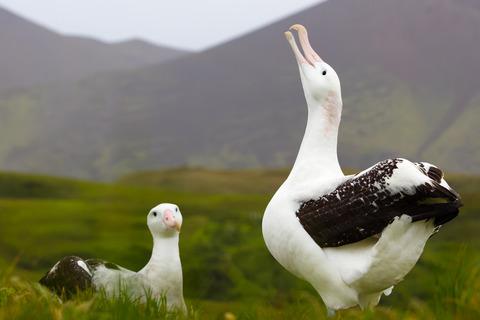当前位置:
X-MOL 学术
›
J. Anim. Ecol.
›
论文详情
Our official English website, www.x-mol.net, welcomes your feedback! (Note: you will need to create a separate account there.)
Sex‐specific effects of wind on the flight decisions of a sexually dimorphic soaring bird
Journal of Animal Ecology ( IF 4.8 ) Pub Date : 2020-06-19 , DOI: 10.1111/1365-2656.13267 Thomas A Clay 1 , Rocío Joo 2 , Henri Weimerskirch 3 , Richard A Phillips 4 , Olivier den Ouden 5, 6 , Mathieu Basille 2 , Susana Clusella-Trullas 7 , Jelle D Assink 5 , Samantha C Patrick 1
Journal of Animal Ecology ( IF 4.8 ) Pub Date : 2020-06-19 , DOI: 10.1111/1365-2656.13267 Thomas A Clay 1 , Rocío Joo 2 , Henri Weimerskirch 3 , Richard A Phillips 4 , Olivier den Ouden 5, 6 , Mathieu Basille 2 , Susana Clusella-Trullas 7 , Jelle D Assink 5 , Samantha C Patrick 1
Affiliation

|
In a highly dynamic airspace, flying animals are predicted to adjust foraging behaviour to variable wind conditions to minimize movement costs. Sexual size dimorphism is widespread in wild animal populations, and for large soaring birds which rely on favourable winds for energy-efficient flight, differences in morphology, wing loading and associated flight capabilities may lead males and females to respond differently to wind. However, the interaction between wind and sex has not been comprehensively tested. We investigated, in a large sexually dimorphic seabird which predominantly uses dynamic soaring flight, whether flight decisions are modulated to variation in winds over extended foraging trips, and whether males and females differ. Using GPS loggers we tracked 385 incubation foraging trips of wandering albatrosses Diomedea exulans, for which males are c. 20% larger than females, from two major populations (Crozet and South Georgia). Hidden Markov models were used to characterize behavioural states-directed flight, area-restricted search (ARS) and resting-and model the probability of transitioning between states in response to wind speed and relative direction, and sex. Wind speed and relative direction were important predictors of state transitioning. Birds were much more likely to take off (i.e. switch from rest to flight) in stronger headwinds, and as wind speeds increased, to be in directed flight rather than ARS. Males from Crozet but not South Georgia experienced stronger winds than females, and males from both populations were more likely to take-off in windier conditions. Albatrosses appear to deploy an energy-saving strategy by modulating taking-off, their most energetically expensive behaviour, to favourable wind conditions. The behaviour of males, which have higher wing loading requiring faster speeds for gliding flight, was influenced to a greater degree by wind than females. As such, our results indicate that variation in flight performance drives sex differences in time-activity budgets and may lead the sexes to exploit regions with different wind regimes.
中文翻译:

风对性别二态翱翔鸟类飞行决策的性别特异性影响
在高度动态的空域中,预计飞行动物会根据多变的风况调整觅食行为,以最大限度地降低移动成本。性别大小二态性在野生动物种群中很普遍,对于依靠顺风进行节能飞行的大型翱翔鸟类而言,形态、翼载荷和相关飞行能力的差异可能导致雄性和雌性对风的反应不同。然而,风与性之间的相互作用尚未得到全面测试。我们在一只主要使用动态翱翔飞行的大型两性异形海鸟中进行了调查,研究飞行决策是否会随着长时间觅食旅行的风的变化而调整,以及雄性和雌性是否存在差异。我们使用 GPS 记录器跟踪了 385 次漂泊信天翁 Diomedea exulans 的孵化觅食之旅,男性是什么 c. 比雌性大 20%,来自两个主要种群(克罗泽和南乔治亚)。隐马尔可夫模型用于表征行为状态——定向飞行、区域限制搜索 (ARS) 和休息——并模拟状态之间响应风速和相对方向以及性别的转换概率。风速和相对方向是状态转换的重要预测因子。鸟类更有可能在更强的逆风中起飞(即从休息转换为飞行),并且随着风速的增加,进行定向飞行而不是 ARS。来自克罗泽的雄性而非南乔治亚的雄性经历了比雌性更强的风,并且来自这两个种群的雄性更有可能在大风条件下起飞。信天翁似乎通过调节起飞来部署节能策略,他们最耗能的行为,以适应有利的风力条件。雄性的行为具有更高的翼载荷,需要更快的滑翔速度,与雌性相比,受风的影响更大。因此,我们的结果表明,飞行性能的变化会导致时间活动预算的性别差异,并可能导致性别利用不同风况的地区。
更新日期:2020-06-19
中文翻译:

风对性别二态翱翔鸟类飞行决策的性别特异性影响
在高度动态的空域中,预计飞行动物会根据多变的风况调整觅食行为,以最大限度地降低移动成本。性别大小二态性在野生动物种群中很普遍,对于依靠顺风进行节能飞行的大型翱翔鸟类而言,形态、翼载荷和相关飞行能力的差异可能导致雄性和雌性对风的反应不同。然而,风与性之间的相互作用尚未得到全面测试。我们在一只主要使用动态翱翔飞行的大型两性异形海鸟中进行了调查,研究飞行决策是否会随着长时间觅食旅行的风的变化而调整,以及雄性和雌性是否存在差异。我们使用 GPS 记录器跟踪了 385 次漂泊信天翁 Diomedea exulans 的孵化觅食之旅,男性是什么 c. 比雌性大 20%,来自两个主要种群(克罗泽和南乔治亚)。隐马尔可夫模型用于表征行为状态——定向飞行、区域限制搜索 (ARS) 和休息——并模拟状态之间响应风速和相对方向以及性别的转换概率。风速和相对方向是状态转换的重要预测因子。鸟类更有可能在更强的逆风中起飞(即从休息转换为飞行),并且随着风速的增加,进行定向飞行而不是 ARS。来自克罗泽的雄性而非南乔治亚的雄性经历了比雌性更强的风,并且来自这两个种群的雄性更有可能在大风条件下起飞。信天翁似乎通过调节起飞来部署节能策略,他们最耗能的行为,以适应有利的风力条件。雄性的行为具有更高的翼载荷,需要更快的滑翔速度,与雌性相比,受风的影响更大。因此,我们的结果表明,飞行性能的变化会导致时间活动预算的性别差异,并可能导致性别利用不同风况的地区。



























 京公网安备 11010802027423号
京公网安备 11010802027423号